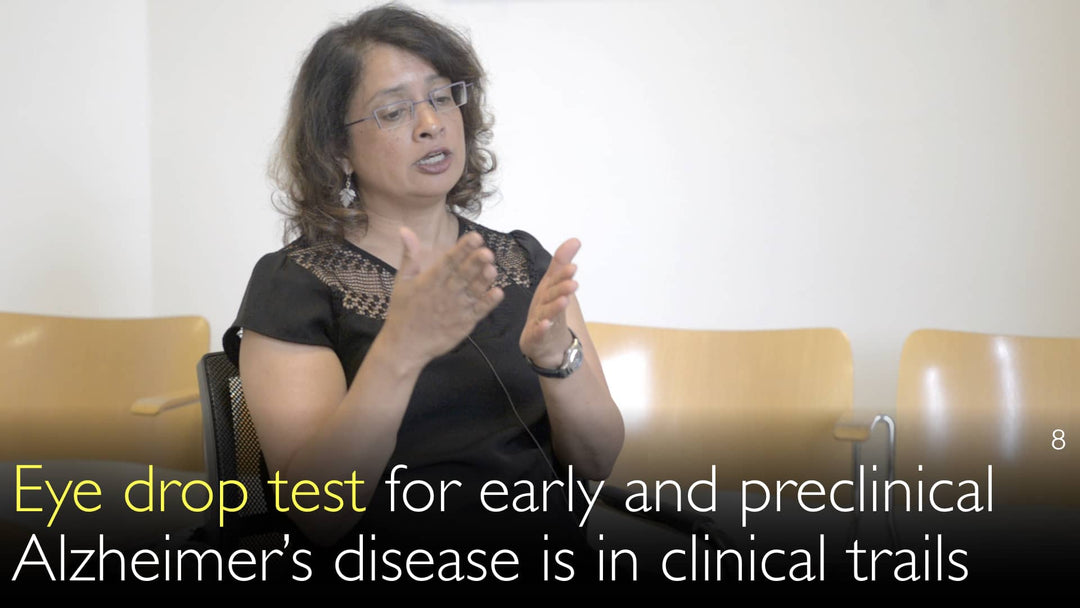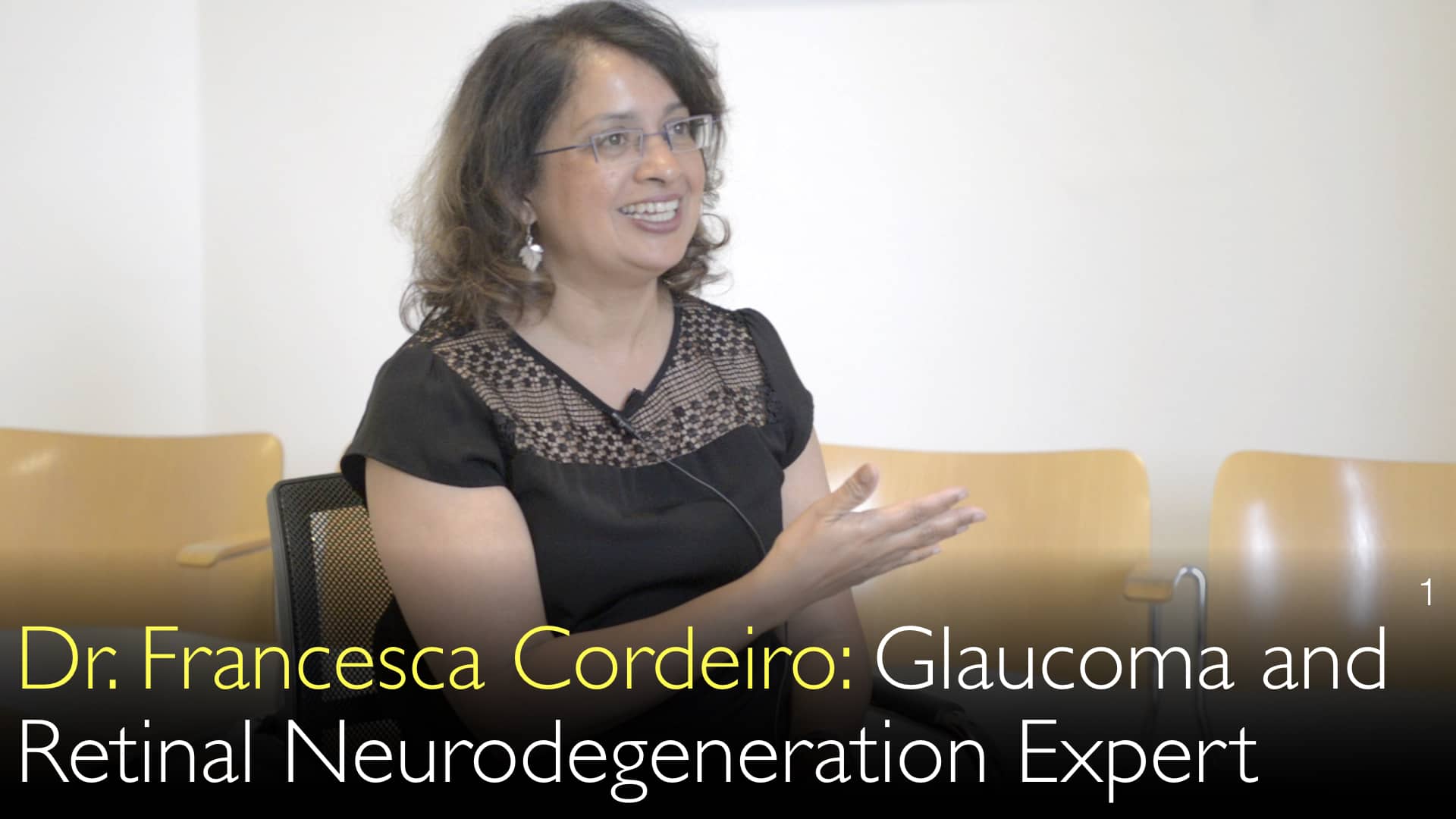Le Dr Francesca Cordeiro, MD, spécialiste de renom en neurodégénérescence et en pathologie oculaire, explique comment le test de collyre DARC permet de détecter précocement la maladie d’Alzheimer en identifiant les cellules rétiniennes en apoptose. Cette méthode diagnostique, potentiellement non invasive et économique, pourrait anticiper le diagnostic jusqu’à vingt ans avant l’apparition des symptômes cliniques de démence. Un essai clinique de phase 2 est actuellement en cours.
Détection précoce de la maladie d’Alzheimer par un simple examen oculaire
Aller à la section
- Explication de la technologie DARC
- Lien entre la rétine et le cerveau
- Essai clinique et syndrome de Down
- Fonctionnement du test oculaire
- L’apoptose comme biomarqueur précoce
- Avenir du diagnostic de la maladie d’Alzheimer
Explication de la technologie DARC
La technologie DARC (Détection des Cellules Rétiniennes en Apoptose) est une nouvelle approche diagnostique pour la détection précoce de la maladie d’Alzheimer. Développée par le docteur Francesca Cordeiro, MD, cette méthode permet d’identifier la mort des cellules nerveuses dans la rétine. Son principe repose sur l’idée que cette apoptose rétinienne reflète la mort neuronale survenant dans le cerveau lors de processus neurodégénératifs.
Cette innovation représente une avancée majeure par rapport aux outils diagnostiques traditionnels, comme l’IRM ou les scanners TEP, qui sont plus coûteux.
Lien entre la rétine et le cerveau
Les yeux offrent une véritable fenêtre sur le cerveau, permettant une observation non invasive de la santé du système nerveux central. Comme le souligne le docteur Francesca Cordeiro, MD, un diagnostic précoce de la maladie d’Alzheimer peut considérablement influencer l’évolution de la maladie chez les patients. Les cellules nerveuses de la rétine sont un prolongement direct du cerveau et partagent des structures et des vulnérabilités similaires.
Les modifications observées au niveau des synapses rétiniennes surviennent en parallèle des changements synaptiques cérébraux, ce qui en fait un indicateur fiable de la santé neurologique.
Essai clinique et syndrome de Down
Un essai clinique de phase 2 est en cours pour valider l’utilisation de la technologie DARC dans le diagnostic de la maladie d’Alzheimer. Le docteur Francesca Cordeiro, MD, précise que l’étude inclut un groupe de patients à haut risque : les personnes atteintes du syndrome de Down. Ces patients présentent un chromosome supplémentaire responsable d’une surexpression de la protéine bêta-amyloïde.
Or, cette même protéine est impliquée dans la formation des plaques cérébrales caractéristiques de la maladie d’Alzheimer. Les personnes atteintes du syndrome de Down développent donc très fréquemment une démence, ce qui en fait une population idéale pour étudier les méthodes de détection précoce.
Fonctionnement du test oculaire
La procédure du test DARC est simple et peu invasive. Un colorant fluorescent est injecté dans le bras du patient, puis circule dans le sang. Des professionnels de santé réalisent ensuite des clichés du fond de l’œil à l’aide d’un équipement similaire à celui utilisé en routine par les optométristes.
Comme le souligne le docteur Anton Titov, MD, l’avantage réside dans l’utilisation de machines relativement abordables, contrairement aux équipements d’imagerie neurologique complexes. Le colorant fluorescent se lie spécifiquement aux cellules nerveuses rétiniennes en cours d’apoptose, ou mort cellulaire programmée, permettant ainsi leur identification.
L’apoptose comme biomarqueur précoce
L’apoptose constitue un biomarqueur précoce essentiel pour des maladies comme Alzheimer et Parkinson. Selon le docteur Francesca Cordeiro, MD, les données expérimentales montrent que l’apoptose des cellules rétiniennes survient très tôt dans le processus pathologique, bien avant l’apparition des symptômes. Dans le glaucome, par exemple, cette mort cellulaire précède la manifestation clinique de la maladie.
Les modèles murins transgéniques apportent des preuves solides que l’apoptose rétinienne est un événement précoce, reflétant les modifications cérébrales dans les affections neurodégénératives.
Avenir du diagnostic de la maladie d’Alzheimer
La technologie DARC pourrait révolutionner le diagnostic et le suivi de la maladie d’Alzheimer. Le docteur Anton Titov, MD, explique que cette méthode permettrait de détecter un état préclinique jusqu’à 20 ans avant l’apparition des symptômes de démence. Une telle avance dans le diagnostic ouvrirait la voie à des interventions potentiellement plus efficaces.
Le docteur Francesca Cordeiro, MD, et son équipe s’attachent à valider ce concept grâce à des essais cliniques en cours, qui confirmeront le lien entre l’apoptose rétinienne et la neurodégénérescence cérébrale.
Transcription complète
La technologie DARC (Détection des Cellules Rétiniennes en Apoptose) repose sur l’identification de la mort des cellules nerveuses dans la rétine, laquelle reflète également la mort neuronale dans le cerveau. Les personnes à haut risque de maladie d’Alzheimer pourraient en tirer un bénéfice significatif.
Les yeux sont une fenêtre ouverte sur le cerveau. Un diagnostic raisonnablement précoce de la maladie d’Alzheimer pourrait faire une réelle différence.
Dr. Anton Titov, MD : Vous avez mis au point un test oculaire spécifique capable d’identifier les patients présentant un risque accru de maladie d’Alzheimer. Ce test permet de détecter un état préclinique jusqu’à 20 ans avant l’apparition des symptômes de démence.
Dr. Anton Titov, MD : Pourriez-vous nous en dire plus sur ce test oculaire que vous avez développé ?
Dr. Francesca Cordeiro, MD : Bien sûr ! Il s’agit de la technologie DARC (Détection des Cellules Rétiniennes en Apoptose). Elle se base sur le fait que la mort cellulaire dans la rétine reflète celle des neurones dans le cerveau.
Dr. Francesca Cordeiro, MD : Pour l’instant, nous n’avons pas encore testé de patients atteints d’Alzheimer. Notre essai clinique de phase 2 débute le mois prochain et inclura un groupe de patients à haut risque.
Dr. Francesca Cordeiro, MD : Ils subiront ce test pour le glaucome et la maladie d’Alzheimer. Il s’agit de patients atteints du syndrome de Down, qui présentent un chromosome supplémentaire.
Dr. Francesca Cordeiro, MD : On observe que, avec l’allongement de leur espérance de vie, ces patients produisent une quantité importante de protéine bêta-amyloïde, impliquée dans les plaques cérébrales de la maladie d’Alzheimer.
Dr. Francesca Cordeiro, MD : Cette surexpression explique le taux très élevé de démence chez les personnes atteintes du syndrome de Down. Nous allons donc étudier cet échantillon de patients.
Dr. Francesca Cordeiro, MD : La procédure DARC consiste à injecter un colorant spécial dans le bras, puis à photographier le fond de l’œil.
Dr. Francesca Cordeiro, MD : L’examen est très similaire à ceux réalisés chez les optométristes et opticiens. L’avantage est que ces machines sont relativement peu coûteuses, surtout comparées à l’IRM ou au TEP.
Dr. Francesca Cordeiro, MD : Le colorant fluorescent injecté identifie spécifiquement les cellules nerveuses rétiniennes en apoptose, comme le confirment nos données expérimentales et la littérature médicale.
Dr. Anton Titov, MD : L’apoptose joue un rôle clé dans la maladie d’Alzheimer et Parkinson. Vous l’observez comme un signe précoce, y compris dans le glaucome, où elle précède la manifestation de la maladie.
Dr. Anton Titov, MD : Bien entendu, cela doit être démontré.
Dr. Francesca Cordeiro, MD : C’est l’objectif de nos essais cliniques. Mais nos modèles murins transgéniques fournissent déjà de solides indications : l’apoptose rétinienne est un événement très précoce.
Dr. Francesca Cordeiro, MD : La mort des cellules nerveuses dans la rétine reflète étroitement les changements synaptiques cérébraux. Les modifications surviennent simultanément dans la rétine et le cerveau.





